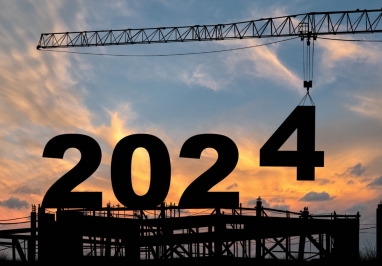
You’ve made it to 2024, so now is the time to look back at prior resolutions and the lessons learned in 2023 to create some goals for 2024. To help, we’ve compiled a new list of contracting resolutions to help you ring in the new year. Make 2024 a success by keeping these top 5 construction contracting resolutions in mind when negotiating construction projects:
1. Confirm Evidence of Owner-Financing
With the continued downturn in the commercial real estate market, inflation, and interest rates not quickly coming back down, it is more important than ever to confirm that the owner has sufficient financial resources to build the project. Industry standard forms typically contain provisions that require the owner to provide evidence of financing, but owners often seek to delete these provisions or omit them in non-standard agreements. Additionally, some owner-financing arrangements require the construction team to eliminate or subordinate lien rights as a condition of financing. The contractor and construction team should perform adequate due diligence to confirm the owner has financial resources to complete the project, and also be mindful of what effect any financing arrangements may have on the construction team’s ability to file liens and recover in the event of an owner default for non-payment.
2. Preservation of Lien Rights
A corollary to #1 above, is that contractors and subcontractors preserve their mechanic’s lien and other statutory payment rights. Recording mechanic’s liens requires strict adherence to applicable statutory deadlines. Failure to comply with such deadlines results in lost lien rights. At the outset, contractors and subcontractors should be careful not to prospectively waive their lien rights by contract. After that, contractors and subcontractors should be mindful of the applicable lien deadlines, which vary by state, and be sure to comply with all such deadlines. Lastly, contractors and subcontractors should implement procedures to comply with applicable deadlines and avoid common calendaring mistakes.
3. Protect against Material Cost Escalation and Supply Chain Issues
Ongoing inflation, supply chain issues, and the rising costs of materials are expected to continue to create challenges and budget uncertainties. Often, material vendors will not commit to a firm price or schedule. As a result, when there are delays or price increases in materials, this often leaves the contractor/subcontractor with liability exposure for any schedule impacts in addition to the increased costs of materials. A solution around this is to require vendors to commit to a firm price and to be bound by the same schedule requirements, and to also provide a performance or supply bond as security. If vendors will not agree, the other option is to negotiate for a material price escalation clause in the upstream contract. Without either option, the subcontractor/contractor could be stuck with a liability gap – meaning they do not have recourse against either the owner/contractor or vendor.
4. Avoid Unlimited/Unpaid Unilateral Changes/Change Directives
The bane of every subcontractor and contractor is unprocessed and/or disputed change orders. If the subcontractor is required to perform changed or additional work, it may end up temporarily financing the project until it receives payment. Often, payment for changed and extra work may not come until years later, well after the work is done and the project is complete. Worse, almost all construction agreements contain provisions that require the contractor/subcontractor to “work through disputes,” meaning the contractor/subcontractor has to continue working even though it does not timely get paid. This combination can leave subcontractors, who typically have limited lines of credit, in financial distress or worse. This also presents challenges for the contractor who may then have subcontractors that cannot finish the project. There is no magic solution, but there are a couple of options to help mitigate this risk. First, the ConsensusDocs industry standard forms contain provisions that where the owner has issued a unilateral change, the owner is obligated to pay the contractor 50% of the estimated cost to complete the changed work (with a true-up at the end of the project). This gives the contractor leverage and allows it (and its subcontractors) to receive some of the disputed funds while the matter remains unsettled. Another option is to negotiate a cap on the amount of changed work that can be directed without payment (e.g., 20% of the base contract amount). Such a provision can help prevent situations where the cost of performing unilateral changes/change directives vastly exceeds the contract amount for the base scope of work.
5. Avoid “One-Way” Attorneys’ Fees Provisions
Many construction industry participants are familiar with a “two-way” or mutual attorneys’ fees provision where the prevailing party in the dispute is able to recover its reasonable attorneys’ fees against the non-prevailing party. Unlike a two-way or mutual prevailing party provision, some contracting parties seek to impose a “one-way” attorneys’ fees provision. Such “one-way” provisions can come in at least two varieties. The first, direct way, is a contract provision that expressly permits only the other party to recover its attorneys’ fees if successful. The second, indirect way, is where there is no express prevailing party provision, but the other party is able to utilize other contract provisions (typically, indemnity) for its ability to recover attorneys’ fees. A “one-way” attorneys’ fees provision can give you a negotiation disadvantage over disputed claims and/or make the pursuit of, smaller claims, even if highly meritorious, cost prohibitive.
And, as always, remember to seek help if you need it. The Construction Law Practice Group at Woods Aitken can help you and your team meet these contracting resolutions. We offer risk management seminars that can be tailored to address unique challenges facing a business and can review and draft contracts to aid in your negotiations. We encourage you to subscribe to our Construction Law E-Briefs for the latest construction news, tips, and updates.
